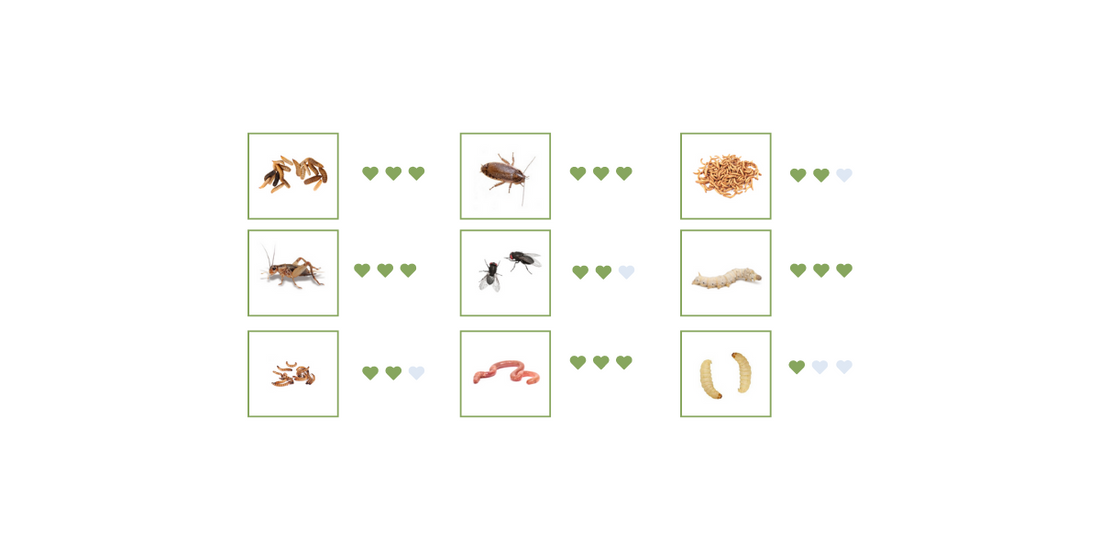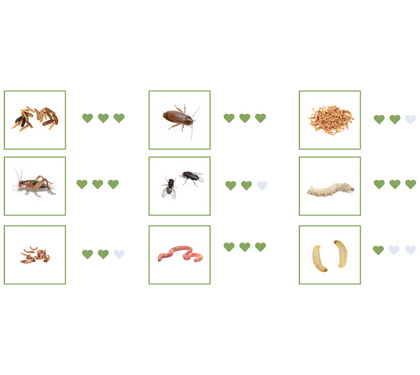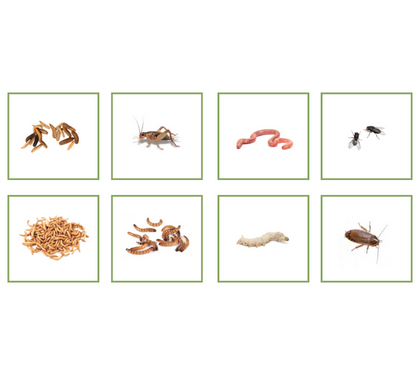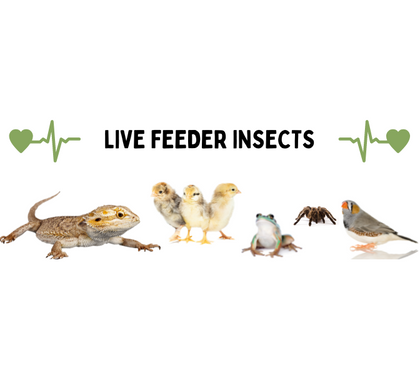The long-term health of your insectivore may depend on you providing them with a nutritious and varied diet. So you might be wondering what are the best live insects for good overall nutrition?
The nutritional value of feeder insects are more or less a mix-and-match of differing levels of moisture, protein, fat, fibre (chitin) and Ca:P ratio. Some feeder insects offer better nutritional value than others but they all have a place in an insectivore's diet.
It is often recommended that a captive diet mimic a wild-type diet as closely as possible; however, it can be challenging to match the diversity of insects found in the wild.
Providing your pet with a wide range of live insects, including both staple and occasional feeders, offers a better variety of nutrients that contribute to overall health.
Common Feeder Insect Categories
-
Staple Feeder
any insect that is eaten routinely and in amounts that form a large part of the diet.
-
Occasional Feeder (Treat)
an insect that offers very little nutritional value or otherwise could cause health problems if fed too often or in large quantities.
-
Never Feed
usually insects that are poisonous or considered high risk of causing harm, e.g. wild-caught insects exposed to herbicides and insecticides.
Lists that separate feeder insects into staple feeders, occasional feeders (or treats), and never feed are generally good to follow as long as you don't limit the variety of insects offered to your pet simply because they aren't commonly accepted as a "good staple" feeder.
Your pet's diet should include more insects that provide the highest nutritional value rather than those that offer little nutrition; But if you strictly follow a list of "staple" live feeder insects, your pet will be missing out on a lot of valuable and sometimes even vital nutrition.
Although it may be common practice,
generally feeding only one or two types
of feeder insects is not nutritionally balanced.
There certainly are live insects that offer better overall nutrition and are often recommended as a staple, but owners and keepers are encouraged to rotate "staple" insects regularly, adding variety by supplementing with other less nutritious insect types.
Live feeder insects can include:
- black soldier fly larvae (BSFL)
- crickets
- common mealworms
- dermestids
- earthworms
- flies & fly pupae
- giant mealworms
- hornworms
- silkworms
- snails
- wax worms
- woodlice
- wood roaches (woodies)
You can see the nutritional values of some common live feeder insects in the Nutrition Chart in our Comparison of Live Feeder Insects blog post.
How To Choose The Right Feeder Insects?
There are a few things to consider when deciding what live insects to feed your pet:
- your pet's dietary needs
- the nutritional profile of feeder insects
- individual preferences of your pet
- cost of live feeder insects
- keeping of live insects and shelf-life
DIETARY NEEDS & NUTRITION
Your pet's dietary needs and the nutritional profile of feeder insects go hand-in-hand. As the health and wellbeing of your pet is directly related to their diet, these are the two most important aspects of feeding your insectivore.
To meet your pet's nutritional requirements, you will need to provide your pet with a range of insects that offer different levels of nutrients.
Don't make the mistake of removing a feeder insect from your pet's diet by completely replacing it with another feeder. Doing this is not nutritionally beneficial to your pet, as each feeder insect offers your pet something different.
VARIETY OF INSECTS
Aside from the nutritional aspect, offering different insects can also help to prevent boredom. The less active feeders support a positive feeding response, while the more active insects exercise your pet's instinctive hunting behaviours presenting more of a challenge, both encourage much needed mental stimulation in captivity.
Although animals are likely to enjoy a varied diet, you should be careful not to make continuous, drastic or sudden changes as this may cause stomach upset.
INDIVIDUAL PREFERENCES
Next is the individual preferences of your animal. While this is something to keep in mind, your pet having a taste for a particular insect should not override the nutritional benefit of feeding a variety of insects.
Let's be honest, your pet would eat their fill in juicy, high-fat mealworms if you let them, but you probably don't because you understand it will lead to health issues.
It is also important to be aware that nutrient-deficient diets can also be the cause of health-related problems, and the best way to offer your pet good nutrition is variety.
COST OF LIVE INSECTS
Another important consideration is the cost of live feeder insects. Prices vary from insect to insect (and supplier to supplier); any price differences, even slight ones, can add up quickly.
Sourcing your live insects from an online supplier often is the most affordable option. Buying in bulk can also save you more as the price per insect usually decreases when you order large quantities. Take into account any postage and handling costs involved as well, as this increases the overall price.
KEEPING LIVE INSECTS & THEIR SHELF-LIFE
Depending on how long it takes for your live insects to be fed-off, you may want to consider the way each type of insect needs to be kept and maintained, including the setup style, cost, time and effort involved.




